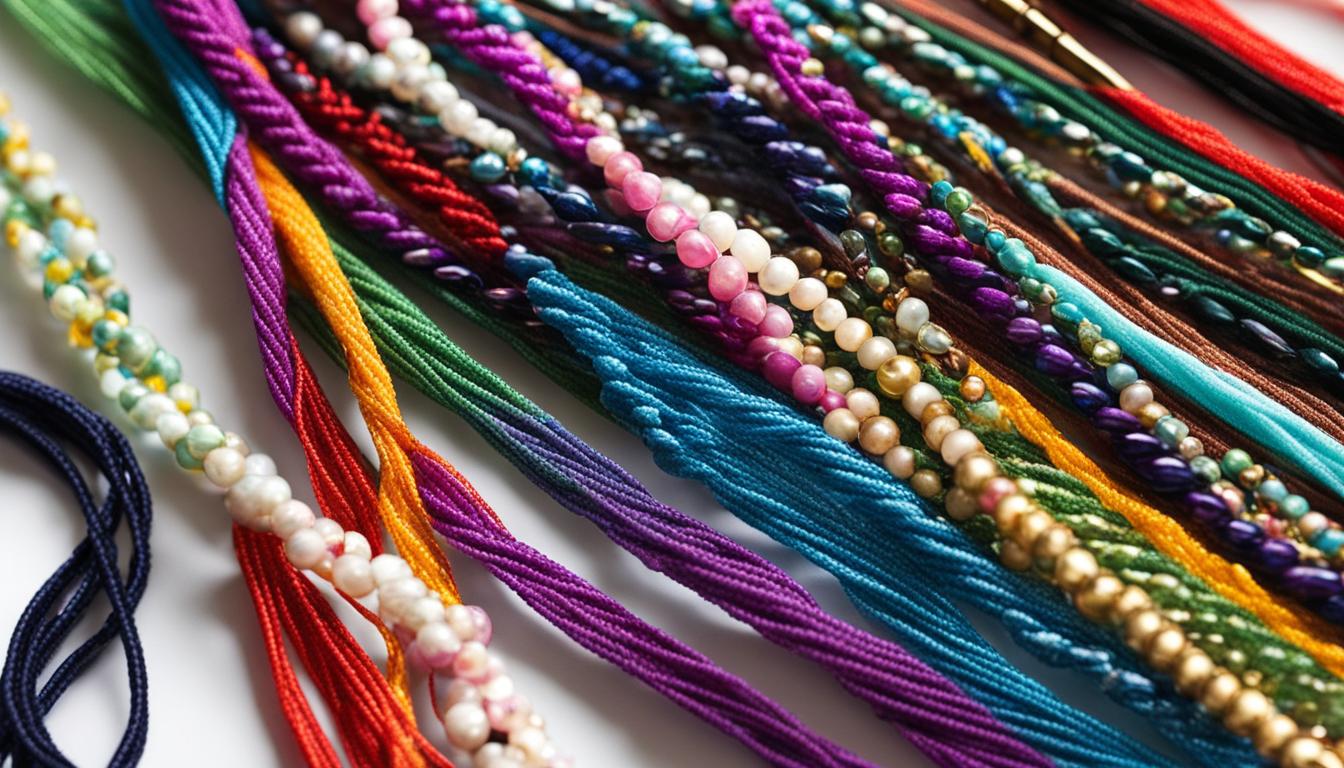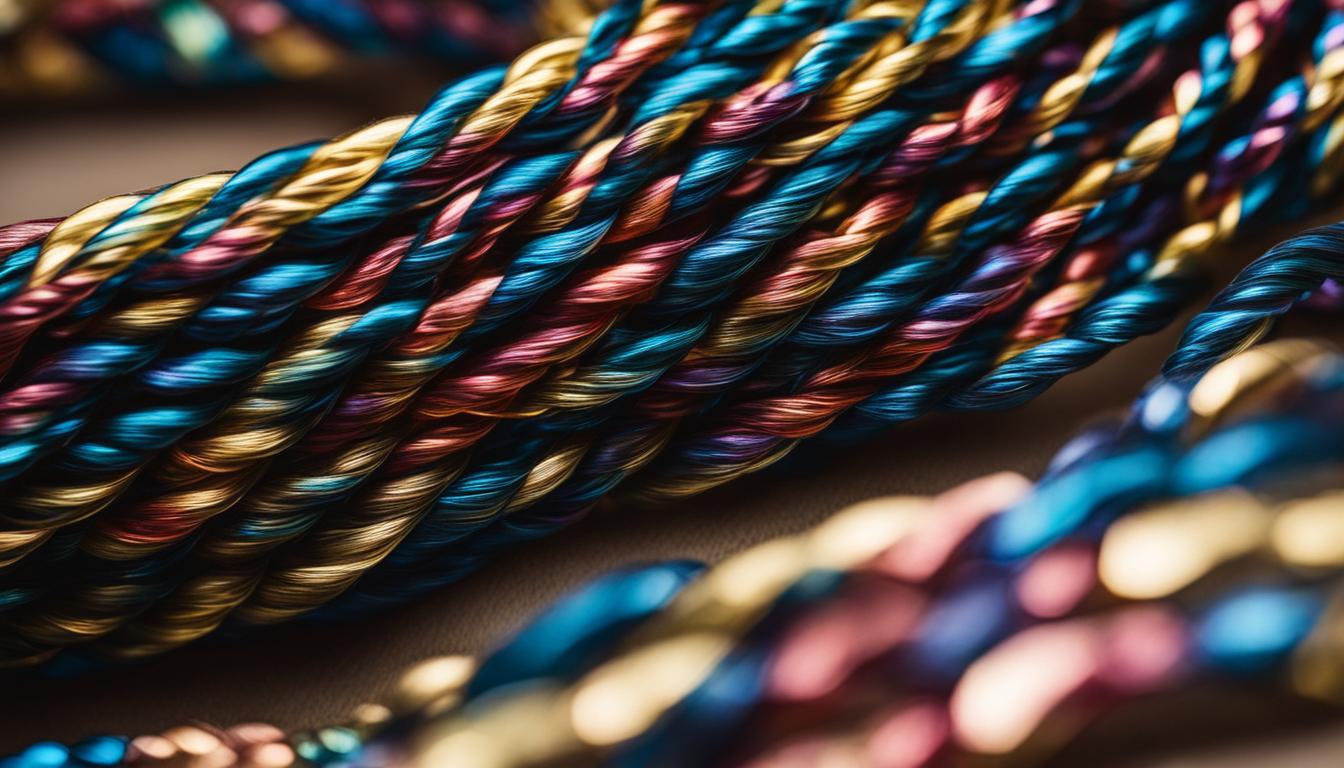Discover the best types of strings for bracelets, including Nymo and KO beading threads, which are ideal for various jewelry-making projects. Enhance your creations with other popular materials such as Superlon cord, cotton cord, and silk strings.
Types of Strings for Bracelets- An Overview
Essential Role of Stringing Material in Bracelet Making
Choosing the right stringing material is super important when making bracelets. The material you pick can change how your bracelet looks and how long it lasts. For example, elastic cords are great for making stretchy bracelets that you can easily put on and take off. Silk strings, on the other hand, give a fancy feel to more classic designs. By knowing about different types of stringing materials, you can make your jewelry projects even better.
Key Factors to Consider When Selecting Stringing Material
When picking stringing materials for your bracelets, keep these key points in mind:
- Durability: You want your bracelet to last! Materials like Fireline thread and nylon cord are strong and hold up well over time.
- Flexibility: Different designs need different levels of flexibility. Elastic cords stretch well, while cotton cords are stiffer.
- Thickness: Make sure the thickness of your string matches the size of your bead holes. If it’s too thick, it won’t fit!
- Color Choices: The color of your string should go well with or stand out against your beads. Options like colored silk threads or bright polyester cords can really make your design pop.
Traditional vs. Modern Stringing Materials
Choosing between traditional and modern stringing materials can change how your bracelet looks and works:
- Classic Silk Threads: These have been used for ages because they feel nice and look good but need careful handling since they’re delicate.
- Contemporary Synthetic Options: Materials like Superlon cord and nylon are popular today because they last longer and come in lots of colors.
Environmental Impact and Sustainability
As someone who cares about the environment, think about where your materials come from:
- Eco-Friendly Choices: Look for biodegradable cords made from natural fibers like hemp or cotton. These options are better for our planet.
- Biodegradable vs. Non-Biodegradable Materials: It’s good to know how synthetic materials impact our environment compared to natural ones over time.
By keeping these things in mind when choosing types of strings for bracelets, you’ll make creations that not only look great but also last a long time while being kind to the Earth.
Diverse Types of Stringing Materials
Nymo Beading Thread
Nymo beading thread is a favorite for many jewelry makers. It’s flexible and strong, which is super helpful! This nylon-based thread comes in different sizes and colors, so you can use it for lots of projects. When you use Nymo, pick the right thickness that fits your bead holes. This way, threading goes smoothly.
Here are some tips to work well with Nymo:
- Use a thread conditioner to stop it from fraying.
- Make sure your knots are tight to avoid problems later.
- Choose needles made for beadwork; they help with easy stringing.
KO Beading Thread
KO beading thread is another great choice. It’s strong and doesn’t stretch much. Many people like using it for small beads or detailed designs. A big plus about KO is that it holds knots really well without slipping.
If you’re new to KO thread, practice tying knots and get to know the best needle types that work with this cord. This will make your projects turn out nice!
Superlon Cord (S-Lon)
Superlon cord, also called S-Lon or nylon cord, is popular for bracelet making because it’s tough and flexible. You can find this cord in many thicknesses and colors, making it easy to match with your beads.
Superlon works great for macramé bracelets and woven designs where strength matters a lot. To make threading easier through beads, cut the cord at an angle before you start.
Cotton Cord
Cotton cord has a soft feel that gives jewelry an organic look. It comes in various thicknesses and can be dyed easily if you want cool colors for your projects.
When using cotton cord, keep these tips in mind:
- Pick the right thickness based on your bead sizes.
- Use a waxed version if you need more durability.
- Try knotting techniques that fit the softness of cotton.
Cotton is eco-friendly and biodegradable but may not last as long as synthetic cords like nylon or polyester.
Silk Strings
Silk strings have been used in jewelry making for ages because they look fancy and feel nice too! They are flexible but still strong, making them perfect for high-end pieces like pearl necklaces or delicate bracelets.
To take care of silk strings:
- Keep them away from water or chemicals since these can weaken them over time.
- Store them out of direct sunlight to keep their quality intact.
Other Popular Materials
Besides traditional threads like Nymo and KO:
- Elastic Cord: Great for stretch bracelets; they let you wear them easily without clasps.
- Fireline Thread: Known as one of the strongest options; it’s perfect for detailed bead weaving where toughness counts.
- Hemp Cord: A natural choice that looks good and helps the environment; often used in boho-style jewelry.
- Polyester Cord: Tough against wear while keeping bright colors; ideal for outdoor jewelry.
- Rattail Cord: Smooth and shiny; adds class but should be used carefully with heavier beads since it might stretch over time.
Each material has its own pros and cons depending on what you’re working on—pick what fits your design best!

Crafting Techniques and Tools for Various Stringing Materials
Best Tools for Stringing Bracelets
When you start making bracelets, having the right tools makes a big difference. You’ll need beading needles to thread materials like Nymo or KO beading threads. Pick a needle that matches the thickness of your cord.
For working with wire and cord, pliers and cutters are essential. They help you shape your designs and make clean cuts.
Don’t forget about crimp beads! These tiny beads are key to securing your creations. Using crimping tools properly will keep your knots tight, so your jewelry lasts longer. Also, invest in good jewelry clasps; they not only help with function but also add style to your bracelets.
Knotting Techniques for Different Cords
Knotting is super important in bracelet making. Basic knotting techniques work well with silk cord and polyester cord, giving you nice finishes while keeping things strong. If you’re feeling adventurous, try advanced knotting using Chinese knotting cord for more intricate designs.
Creating a simple guide with step-by-step instructions can really help beginners learn how to secure their beads well. This adds beauty while also making sure their pieces hold up over time.
Handling Challenges in Bead Stringing
Every jewelry maker faces challenges when stringing beads, especially with different bead hole sizes. For those larger hole beads, thicker cords or special threads work best. For smaller holes, use thinner threads or specific knotting techniques to fit snugly without losing strength.
Discussing these common issues can give valuable tips on how to tackle them effectively. Knowing how to adjust your methods will make your finished pieces look better and last longer.
Combining Multiple Stringing Materials
Mixing different stringing materials lets you create unique looks while boosting durability in bracelet making. Try pairing elastic cords with metal wire or cotton cords with leather thonging for cool contrasts that still hold together nicely.
Sharing examples of successful hybrid projects can inspire others too! Tips on balancing different materials will encourage makers to try new design ideas confidently.
Ensuring Your Jewelry is Secure
To keep your bracelets strong over time, using the right closures is key. Different types of jewelry clasps enhance both functionality and style in each piece you create.
Plus, don’t skip tips on reinforcing knots! Techniques like double-knotting or using special adhesive made for jewelry can greatly improve how long your pieces last during wear. Making sure everything is secure means happy wearers who love both the beauty and strength of their jewelry!

Specialized Stringing Materials and Their Unique Features
Memory Wire
Memory wire is a great choice for jewelry making, especially for creating unique designs. This special wire keeps its shape even when bent, which makes it perfect for crafting stunning bracelets that fit any wrist size. When you work with memory wire, be sure to use heavy-duty cutters since it can be tough to cut through. You can layer beads of different shapes and sizes to make eye-catching pieces. To keep your ends secure, don’t forget to use crimp beads or glue.
Flex-Rite Beading Wire
Flex-Rite beading wire is known for being strong and flexible. It’s a fantastic option for projects that need durability but still want a delicate look. Whether you’re designing bracelets or necklaces, using Flex-Rite lets you show off your beads beautifully. To keep your design intact, think about using crimp beads while putting everything together. This kind of beading wire works well for minimal jewelry designs where the focus stays on the beauty of the beads.
Illusion Cord
Illusion cord is popular among crafters because it makes jewelry pieces look like they are floating due to its nearly invisible nature. This feature makes it ideal for necklaces and delicate bracelets that need a touch of charm without being too flashy. To take care of your illusion cord properly, try not to expose it to too much moisture or direct sunlight; both can weaken the material over time.
Micro Fiber Suede Cord
Micro fiber suede cord adds a soft texture that gives any bracelet project a luxurious feel. Its versatility allows crafters to use it in many styles, from casual everyday wear to fancy evening pieces. When working with micro fiber suede cord, handle it gently during knotting; pulling too tightly can cause fraying and damage the material. This type of stringing opens up creative possibilities for modern bracelet designs.
Leather Thonging
Leather thonging brings a rustic charm that many jewelry makers love. It’s durable yet flexible enough for various bracelet styles, including braided or knotted designs. The natural resistance of leather makes it suitable for outdoor settings as well; however, remember that leather may need regular conditioning to stop it from drying out or cracking over time. Knowing both the benefits and drawbacks of leather thonging will help you make smart choices when using this material in your projects.

